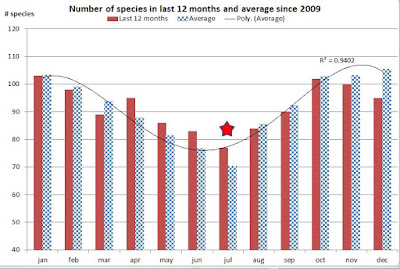There have been a number of less common species sighted this
month. Bird of the month was a female
Koel reported from Knox Close on the 15th. Photo by Sandra.
Other less common species
have been an Eastern Barn Owl (Captains Flat Rd); Whistling Kite at Wanna Wanna Rd and Rainbow Bee-eaters (Forbes
Creek). The Avocets and Stilts at Foxlow Lagoon and the Banded
Lapwings on the Plain are ongoing, having almost advanced to resident status.
Despite that list of less common species overall diversity was quite low. We have recorded 96 species for the month which contrasts poorly with the November average of 103 species.
There seems to be a particular shortage of waterbirds (associated no doubt with the shortage of water) and raptors (plenty of road kill but I suspect little live prey).
As with last month quite a few (16, marked in red below) species have been recorded as breeding. ‘Our’ Tawny Frogmouth family have left the
nest and are exploring the area around our house.
The Masked and White-browed Woodswallows on
the Plain are engaging in the early stages of the breeding cycle (ie copulation). They may be nesting but the vegetation is too thick to spot the nests. Several other species have been seen on nests.
Return migration is close to complete with about equal
numbers of species on time and late. Few
species were early. Except for Pallid
Cuckoo, cuckoos in particular are thin in the air, although 5 species have been logged at least once in the month. Migrants are highlit in orange below.
Thanks to observers from Wanna Wanna Rd, Knox Close, Captains Flat Rd, Whiskers Creek Rd, Hoskinstown Village and Plain and Forbes Creek. Please pass on interesting sightings to me by email to martinflab@gmail.com.
1 Waterbirds (pt 1): (pt 2); (Pt 3); (Pt 4): Australian Wood Duck; Grey Teal; Pacific Black Duck; Australasian Grebe; Little Pied Cormorant; Great Cormorant; Eastern Great Egret: White‑faced Heron; Eurasian Coot; Black-winged Stilt; Red-necked Avocet; Masked Lapwing; Banded Lapwing; Australian
2 Birds of Prey: Whistling Kite, Wedge-tailed Eagle; Nankeen Kestrel
3 Parrots and Relatives: Yellow-tailed Black-Cockatoo; Gang‑gang Cockatoo; Galah; Little Corella; Sulphur‑crested Cockatoo; Australian King‑parrot; Crimson Rosella; Eastern Rosella; Red-rumped Parrot
4 Kingfishers and other non-songbirds (Pt 1) (Pt 2) (Pt 3): Common Bronzewing; Crested Pigeon; Tawny Frogmouth; Common Koel; Horsfield's Bronze‑Cuckoo; Shining Bronze‑cuckoo; Pallid Cuckoo; Fan‑tailed Cuckoo; ; Southern Boobook; Eastern Barn Owl; Azure Kingfisher; Laughing Kookaburra; Sacred Kingfisher; Rainbow Bee‑eater; Dollarbird;
2 Birds of Prey: Whistling Kite, Wedge-tailed Eagle; Nankeen Kestrel
3 Parrots and Relatives: Yellow-tailed Black-Cockatoo; Gang‑gang Cockatoo; Galah; Little Corella; Sulphur‑crested Cockatoo; Australian King‑parrot; Crimson Rosella; Eastern Rosella; Red-rumped Parrot
4 Kingfishers and other non-songbirds (Pt 1) (Pt 2) (Pt 3): Common Bronzewing; Crested Pigeon; Tawny Frogmouth; Common Koel; Horsfield's Bronze‑Cuckoo; Shining Bronze‑cuckoo; Pallid Cuckoo; Fan‑tailed Cuckoo; ; Southern Boobook; Eastern Barn Owl; Azure Kingfisher; Laughing Kookaburra; Sacred Kingfisher; Rainbow Bee‑eater; Dollarbird;
5 Honeyeaters: Eastern Spinebill; Yellow-faced Honeyeater; White-eared Honeyeater; Noisy Miner; Red Wattlebird; Brown‑headed Honeyeater; White-naped Honeyeater; Noisy Friarbird;
6 Flycatchers and similar species: Golden Whistler;Rufous Whistler; Grey Shrike-thrush; Grey Fantail; Willie Wagtail; Leaden Flycatcher; Magpie-lark; Scarlet Robin; Red‑capped Robin, Welcome Swallow; Tree Martin
7 Thornbills, Finches and similar species (Pt 1) (Pt 2): Superb Fairy-wren; White-browed Scrubwren; Weebill; Western Gerygone; White-throated Gerygone; Striated Thornbill; Yellow‑rumped Thornbill; Buff‑rumped Thornbill; Brown Thornbill; Striated Pardalote; Silvereye; Red‑browed Finch; House Sparrow; European Goldfinch
8 Other, smaller birds: White-throated Treecreeper; Black-faced Cuckoo-shrike; White‑-winged Triller; Olive‑backed Oriole; Masked Woodswallow; White‑browed Woodswallow; Dusky Woodswallow;Australian Reed-warbler; Rufous Songlark; Common Blackbird; Common Myna; Common Starling; Mistletoebird; Australasian Pipit;
9 Other, larger birds: Satin Bowerbird; Grey Butcherbird; Australian Magpie; Pied Currawong; Grey Currawong; Australian Raven; Little Raven; White-winged Chough










